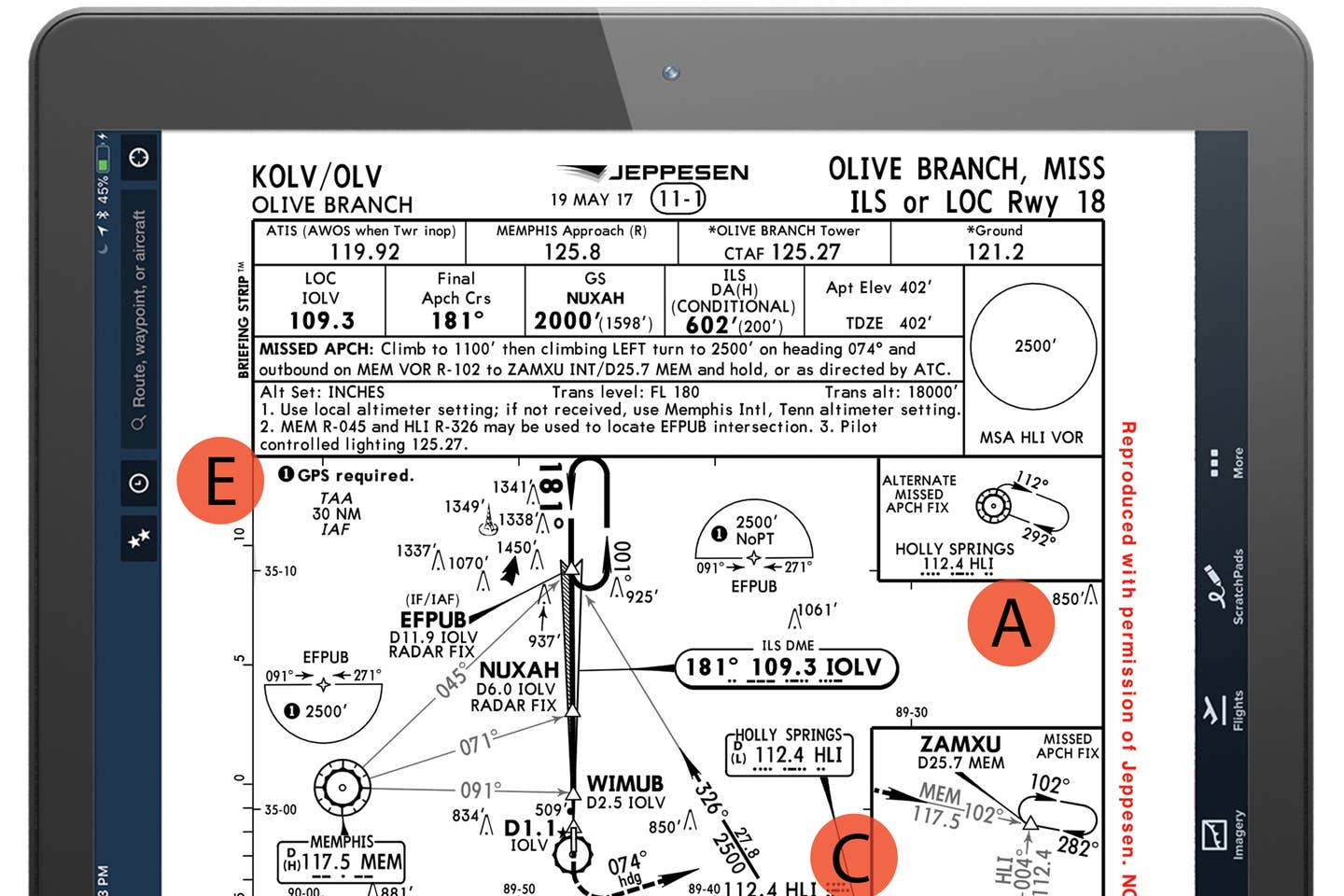
This approach offers a number of caveats based on whether the pilot uses alternate altimeter settings. Jeppesen
Olive Branch—in Mississippi— might not be a city that easily rolls off the tongue of pilots everywhere, but as the crow flies, Olive Branch Airport (KOLV) is just 26 miles from Memphis International (KMEM), home base to package-delivery giant FedEx. That airline alone adds some 450 daily operations to KMEM. But KMEM’s nearly 230,000 annual operations include plenty of traditional airlines bringing people to listen to soul, blues, rock ‘n’ roll, and maybe even visit the Graceland palace that was once home to the King, Elvis Presley.
Each year, about 65,000 aircraft arrive and depart at Olive Branch, many just to avoid the traffic chaos at KMEM. While this month’s ILS appears very straight forward on the surface, it contains a number of notes that could confuse any pilot who skips over them too quickly.
A. Missed Approach, “Or As Directed by ATC”
KOLV’s primary missed approach takes aircraft out to hold at ZAMXU intersection. But pilots should be ready for a different instruction, based on the note in the textual description that says “…or as directed by ATC.” That means be ready to possibly head to Holly Springs VOR (HLI), farther to the south from ZAMXU. Alternate missed approach points are often used to further separate traffic or if multiple aircraft are holding at the same time because of poor weather conditions. Because no other published notes relate to this procedure, a pilot should expect to use the same altitude for the secondary hold—2,500 feet—as the primary missed approach procedure, “or as directed by ATC.”
B. Where does the missed begin?
Despite the fact that the DME for the procedure is being transmitted from the localizer itself, don’t expect the DME to indicate zero when the aircraft arrives at the MAP, whether shooting the localizer-only approach or the full ILS. In either case, the DME will actually read 1.1 from IOLV.
C. Finding WIMUB
The lowest minimums on the KOLV localizer-only approach are based on two items: identifying WIMUB and the pilot’s choice of an altimeter setting. This procedure can become a bit confusing though because there are two different locations on the plate with a Note 1—the first in the plan view indicating a GPS is required and the other in the minimums box that calls for dual VOR or DME. The top Note 1 relates to the terminal- advisory-area semicircles that have begun replacing the MSA boxes on old plates. Technically, you’d be unable to identify either of those TAAs without GPS. The bottom Note 1 is for something completely different and relates to localizer-only approach minimums when the pilot identifies WIMUB as the intersection of the localizer at 2.5 DME and the 091-degree radial of the MEM VOR. That requires the capability to receive two VOR/LOC signals—or have DME.
Check out more charts: Chart Wise
D. Remember how to time an approach?
Pilots can easily become reliant on the DME or GPS to indicate the precise point when a missed approach becomes necessary. There are fewer and fewer approaches where time to missed approach can be used, but it never hurts to practice the now nearly ancient method of timing from the FAF based on groundspeed, as shown in the chart on the left side of the plate. Once established inbound on the approach from the EFPUB intersection, a pilot flying at 100 knots groundspeed would start their timing once they cross the NUXAH FAF and follow the localizer until two minutes and 56 seconds have elapsed. If they’re still in the soup when the time runs out, the only alternative is a missed approach.
E. When the pilot is responsible for the lights
The Olive Branch control tower on 125.27 normally activates the runway lights for pilots. But that facility isn’t open 24 hours a day, as noted by the asterisk in the briefing bar next to the frequency and also by Note 3 in the briefing section. A pilot arriving after the tower has closed must turn on the runway lights if they’re to have any chance of finding the runway when they break out of the clouds.
This story appeared in the May 2020 issue of Flying Magazine

Sign-up for newsletters & special offers!
Get the latest FLYING stories & special offers delivered directly to your inbox






